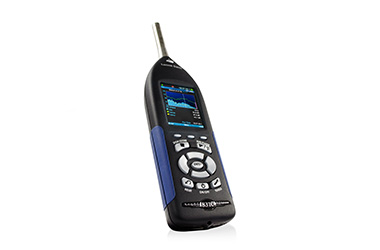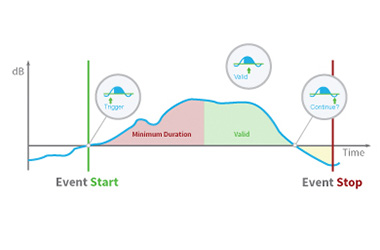Main Menu
- Home
- Products
- Applications
- Product Support
- Service
- Learn
- Product News
- About Us
- Contact Us
 While Time Histories are typically logged at one sample per second,
longer-term averages are often useful to see trends, e.g., 10 minute or hourly averages. 831C-ELA firmware enables Measurement History (MH) and logs these parameters similar to Time History
(TH) over a longer interval time. MH and TH can run together
simultaneously or independently.
Data for each measurement or location is saved in a unique MH
record and may include the Leq, Lmax, Lmin, SPL, and statistical
distribution of the SPL (Ln). A complete set of MH records then
can be stored in a single measurement that keeps all the noise
survey data in a single file. Finally, an automated sound recording
at the beginning of each MH period can be achieved with 831C-SR
firmware.
While Time Histories are typically logged at one sample per second,
longer-term averages are often useful to see trends, e.g., 10 minute or hourly averages. 831C-ELA firmware enables Measurement History (MH) and logs these parameters similar to Time History
(TH) over a longer interval time. MH and TH can run together
simultaneously or independently.
Data for each measurement or location is saved in a unique MH
record and may include the Leq, Lmax, Lmin, SPL, and statistical
distribution of the SPL (Ln). A complete set of MH records then
can be stored in a single measurement that keeps all the noise
survey data in a single file. Finally, an automated sound recording
at the beginning of each MH period can be achieved with 831C-SR
firmware.
When the SoundAdvisor™ Sound Level Meter Model 831C is set to MANUAL RUN mode, Measurement History can be used to construct a noise survey. Data for each measurement or location is saved in an individual file and may include the Leq, maximum and minimum SPL and statistical distribution of the SPL (Ln).
Measurement History records are available for easy review on SoundAdvisor. The current measurement is visible on the “Current” display tab, while completed measurements can be browsed in the “Measurement” tab. When combined with
831C-LOG, the time history detail of each measurement can be viewed quickly using keypad shortcuts. Finally, an automated sound recording at the beginning of each measurement can be achieved with 831C-SR firmware.
In the SoundAdvisor Sound Level Meter Model 831C, events are defined as either:

Event Definition on SoundAdvisor: An event begins when the measured sound level exceeds at least one static or dynamic Trigger Level and persists longer than the Minimum Duration defined in the measurement setup. The even stops when the sound level drops 2 dB below the trigger level for longer than the Continuation Duration defined in the measurement setup.
With 831C-ELA firmware, event definition is defined by you – including threshold level, duration, and event continuation period when the SPL drops below the threshold level for a specific period of time. Triggering status icons identify event progression and qualification (see graph above).
The Model 831C can automatically generate an email alert to provide fast notice of any noise exceedance. The event alerts can be sent to a user configurable list of email addresses or by text message using an email to MMS gateway. Email event sound recording in conjunction with option 831C-SR.
The “Event” tab contains detailed information on each event including:
A DYNAMIC trigger method can also be selected. The dynamic trigger is set to trigger when L85, L90 or L95 is exceeded by a predetermined number of decibels. A rise time can also be specified to determine how quickly the meter responds to changes in the
background noise level. By utilizing the dynamic trigger, the number of false triggers is reduced and events (significant noise above background level) are better determined. Learn more about dynamic triggering.
| 831C-ELA Specifications | |
|---|---|
| Measurement History Parameters | |
| Interval Time | 1 min to 99 hr |
| Logging Parameters | Same as Overall Measurements Ln Statistics + Spectral Ln (if OB1 or OB3 enabled) |
| Sound Record Tagging | At start of each interval (required to enable SR) |
| Event Logging Period | 20 ms to 5 s (independent of TH or MH) |
| Logging Parameters | Leq, Lmax, Lpeak, Date and Time, Duration, Exposure in dB and Pa2s, and available spectral Leq and maximum. Event Time History is also available with broadband and spectral levels. |
| SEL | Yes (LAE) |